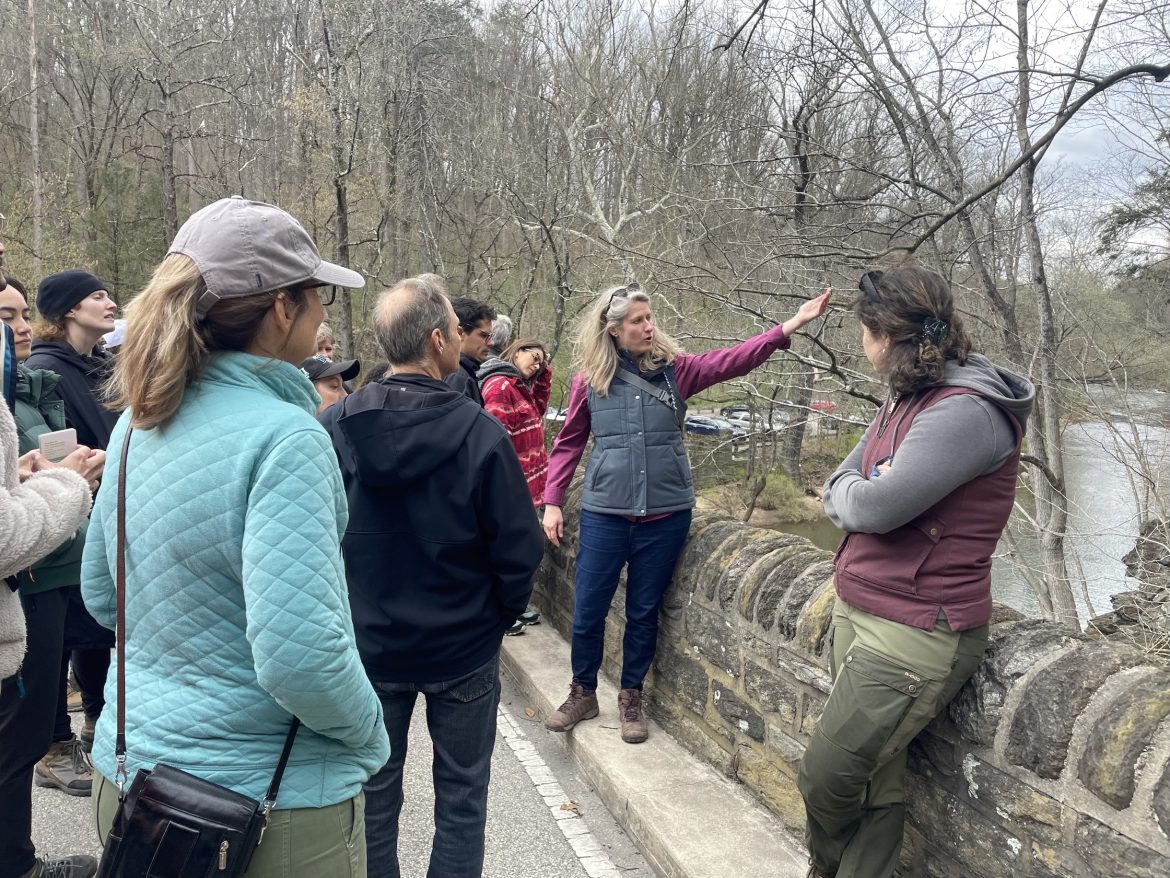By Shealyn Paulis
Editor’s note: This is one in a series of stories coming out of a recent meeting of the Society of Environmental Journalists in Philadelphia.

Ruffian Tittman of Friends of Wissahickon explains that the journalists touring Wissahickon Valley Park have arrived on opening day of trout season. Image: Shealyn Paulis
Nestled in the heart of an urban and busy city, Wissahickon Valley Park of Philadelphia provides a place for city dwellers to enjoy the sanctuary of nature.
A popular spot for outdoor enthusiasts, historians and even wedding-goers, the park houses over 50 miles of trails and encompasses over 2,000 protected acres along a stretch of the Wissahickon Creek as it passes through northwest Philadelphia.
Some Society of Environmental Journalists members had the opportunity to explore the greenery during their recent annual conference.
The nonprofit group Friends of Wissahickon led the tour. This group works year-round to maintain, preserve and protect the park and has since 1942, explained Ruffian Tittmann, the organization’s executive director.
Tittmann guided the tour of more than 30 environmental journalists along a park trail while providing historic and park information. She was joined by tour leaders Frank Kummer, environmental reporter for The Philadelphia Inquirer, Rebekah Ward, climate and environment reporter for the Houston Chronicle, and Pauline Berkowitz, project manager for Friends of Wissahickon.

Pauline Berkowitz, project manager for Friends of Wissahickon, is responsible for planning, funding, and executing capital projects in Wissahickon Valley Park. Here, she explains the features of Devil’s Pool. Image: Shealyn Paulis
Tittmann says Friends of Wissahickon implements preservation practices to maintain a clean park.
But this can prove difficult, as it is such a popular summer recreation spot, she said. Parts of the park get very congested and polluted in the busy months when there can be more than 1,000 daily visitors.
Popular swimming spots pose an annual dilemma, Tittman said. “The Devil’s Pool area is a very popular summer destination, but one of the big challenges of [regulating] use in the Wissahickon,” said Tittman. “Really, one of the most beautiful places as well.”
Friends of Wissahickon applies a range of conservation efforts in the park. To fight eroding river banks and moving soils, Tittmann said the group prioritizes plantings that help anchor the bank. Friends of Wissahickon provide restrooms and sustainable trails and bridges designed to limit erosion and minimize human impact, she said.

Rick Howley, an environmental engineer with the Philadelphia Water Department, explains engineering features of Wissahickon Valley Park that help maintain the park’s safety, accessibility and sustainability. Such features include stormwater runoff management to minimize erosion and protect the riverbank stability and maintain trails for visitors. Image: Shealyn Paulis
Intentional design of the park can be dated back to its inception, said Rick Howley, an environmental engineer with the Philadelphia Water Department. Original water system designs used the natural paths of the creeks and streams, with pipelines running next to or alongside them, he said. This structure lessened energy requirements to get water throughout the city, as it used the natural water paths and gravity to move water efficiently.
The tour participants took a scenic hike, sighted an atypical seabird and enjoyed spectacular views of Wissahickon Valley Park.
“Wissahickon is a magical place,” Tittman said.
